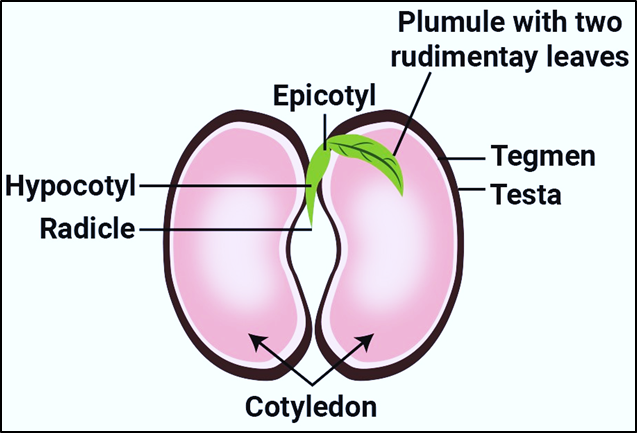
Differentiate between the following pair of the terms testa and tegmen?
Answer
495.6k+ views
Hint: Testa is one of the two seed coats of the dicot seed; it serves as the outer layer of the seed coat. The main function of the testa is to protect the embryo of the seed from the mechanical damages and dehydration during the period of the seed dispersal. Tegmen is the second seed coat of the dicot seed it occurs only in bitegmic seeds dicot. Tegmen is derived from the different layers of the inner integument of the ovule.
Complete answer:
- The outermost covering of the seed is the seed coat. The seed coat has two layers: the outer testa and inner tegmen.
Tabular Column: Difference between Testa and Tegmen
Figure 1: Diagram showing different parts of a seed

Additional information:
The hilum is a scar on the seed coat through which the developing seeds were attached to the fruits. Above the hilum is the small pores called the micropyle. Within the seed coat is the embryo consisting of the embryo axis and the two cotyledons. The cotyledons are fresh and are full of reserve food materials. At the two ends of the embryo, the axis is present to the radicle and the plumule. In testa after fertilization, the outer integument of the ovule develops into the testa. In tegmen the nucleus of the ovule is covered and protected by one or more membranes called tegmen.
Note:
In some seeds such as castors the endosperm formed as the result of the double fertilization is the food storing tissue. In plants such as bean gram and the pea, the endosperm is not present in the mature seeds and such seeds are called non-endospermous. Testa is the outermost covering of the seed which protects the seeds from the external injury and bacterial infection whereas, tegmen is the covering of the seed that lies just under the testa.
Complete answer:
- The outermost covering of the seed is the seed coat. The seed coat has two layers: the outer testa and inner tegmen.
Tabular Column: Difference between Testa and Tegmen
| Features | Testa | Tegmen |
| Structure | The protective outer covering | The protective inner layer of the seed |
| Derived structure | Derived from the outer integument of the ovule | Derived from the inner integument of the ovule |
| Thickness | Smooth and thick | Thin |
| Permeability | Impermeable | Membraneous |
| Colour | Brown | White |
| Made of two layers called | Endotesta and exotesta | Endotegmen and exotegmen |
| Function | Plays a role during seed dormancy by not allowing water to enter and protect the seed. | Protects the embryo from dehydration and mechanical damage |
Figure 1: Diagram showing different parts of a seed

Additional information:
The hilum is a scar on the seed coat through which the developing seeds were attached to the fruits. Above the hilum is the small pores called the micropyle. Within the seed coat is the embryo consisting of the embryo axis and the two cotyledons. The cotyledons are fresh and are full of reserve food materials. At the two ends of the embryo, the axis is present to the radicle and the plumule. In testa after fertilization, the outer integument of the ovule develops into the testa. In tegmen the nucleus of the ovule is covered and protected by one or more membranes called tegmen.
Note:
In some seeds such as castors the endosperm formed as the result of the double fertilization is the food storing tissue. In plants such as bean gram and the pea, the endosperm is not present in the mature seeds and such seeds are called non-endospermous. Testa is the outermost covering of the seed which protects the seeds from the external injury and bacterial infection whereas, tegmen is the covering of the seed that lies just under the testa.
Recently Updated Pages
The correct geometry and hybridization for XeF4 are class 11 chemistry CBSE

Water softening by Clarks process uses ACalcium bicarbonate class 11 chemistry CBSE

With reference to graphite and diamond which of the class 11 chemistry CBSE

A certain household has consumed 250 units of energy class 11 physics CBSE

The lightest metal known is A beryllium B lithium C class 11 chemistry CBSE

What is the formula mass of the iodine molecule class 11 chemistry CBSE

Trending doubts
Is Cellular respiration an Oxidation or Reduction class 11 chemistry CBSE

In electron dot structure the valence shell electrons class 11 chemistry CBSE

What is the Pitti Island famous for ABird Sanctuary class 11 social science CBSE

State the laws of reflection of light

One Metric ton is equal to kg A 10000 B 1000 C 100 class 11 physics CBSE

Difference Between Prokaryotic Cells and Eukaryotic Cells




